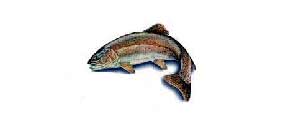

Oncorhynchus mykiss
Rainbow trout (Oncorhynchus mykiss) are native to western North America and have been cultured for over 100 years. Over the last several years, the U.S. trout industry has been relatively stable in numbers of operations and value of sales and output. The state of Idaho produces the most trout in the United States (41 million pounds sold in 1998). North Carolina leads trout production (3.5 million pounds sold in 1998) in the southeastern states. Kentucky trout production is limited by the availability of large freshwater springs which provide gravity-fed water in adequate quantity. These springs must have a year round supply of contaminant free water. To insure trout survival, water temperature should rarely exceed 70 degrees F. For a small trout facility to provide supplemental income, flow rates of approximately 350-500 gallons per minute would be required. Small scale, full time trout farming would require flow rates of 1,000-2,000 gallons per minute. Most Kentucky trout farms are equipped with egg incubation facilities. Eyed eggs are typically purchased from commercial brood fish farms located in the western United States. Trout and trout eggs should be certified to be free of diseases. Commercial culture occurs primarily in concrete raceways. Large volumes of water flow via gravity through a series of 4-8 raceways and is discharged into a receiving stream. Densely stocked fish are supplied with cold water which is rich in dissolved oxygen. The water flow removes wastes from the culture unit and is replenished with oxygen when spilled into the next raceway. The water flow rate, water chemistry, temperature, size of fish, and the rate of feeding determines the volume of fish that can be produced in a particular raceway system. Average values are 20-40 pounds of fish per gallon per minute flow rate per year. Trout may also be stocked in ponds during late fall (October or November) at a rate of 1000-1200 fish per acre in ponds which allow seining and do not contain largemouth bass. During the winter, trout may also be grown in suspended cages and net pens. Trout, 8-10 inches in length are stocked in ponds, cages or net pens, in order to reach marketable size by spring (March or April). Six fish may be stocked per cubic foot of volume of a cage or net pen. Currently, production and marketing research is underway to investigate profitable alternative water sources for growing trout. These would include waters associated with coal mining operations in eastern Kentucky. South Eastern Community College in Cumberland, Kentucky has been developing a trout production demonstration site as a result of a KDA Value-added Grant. S. E. Community College estimates there may be as many as 500 suitable trout production sites in Harlan, Bell, and Letcher Counties using water from abandoned deep coal mines. Grow-out culture and test marketing of winter, pond-raised trout is currently being conducted in fallow freshwater shrimp ponds. However, the high cost of stocker trout, feed, and poorly developed markets contribute to uncertain profitability of seasonal trout production. Efforts are underway to provide lower cost, advanced trout fingerlings for winter stocking. The KAA has applied for and been awarded a KDA Value-added Grant to contract with a trout producer to supply a lower cost source of Kentucky raised fingerlings. Cooperative purchase of larger feed shipments will be organized to reduce costs. Test marketing of small volumes of fresh trout is being conducted. |